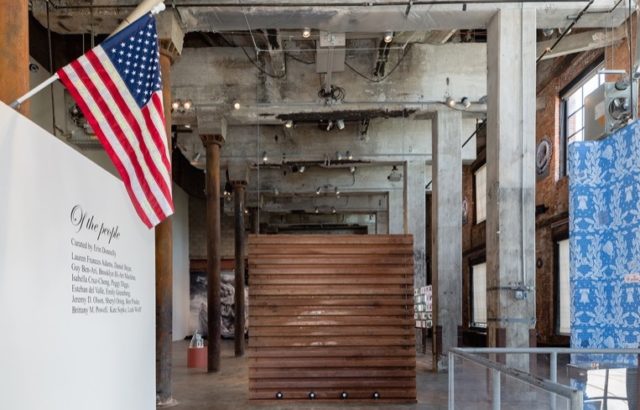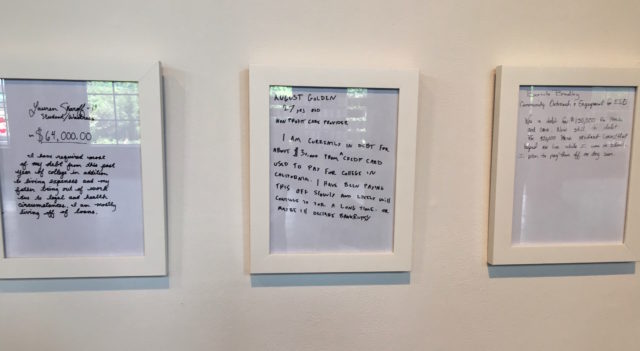
Installation view of “Of the people” at Smack Mellon including Isabella Cruz-Chong’s Line of Breath (center) (Photo by Etienne Frossard; image courtesy Smack Mellon)
Of the people
Smack Mellon
92 Plymouth Street, Brooklyn, NY
On view until July 31, 2016
Artists: Lauren Frances Adams, Daniel Bejar, Guy Ben-Ari, Brooklyn Hi-Art Machine (Mildred Beltre & Oasa DuVerney), Isabella Cruz-Chong, Peggy Diggs, Esteban del Valle, Emily Greenberg, Alicia Grullon, Jeremy D. Olson, Sheryl Oring, Ben Pinder, Brittany M. Powell, Kate Sopko, t.Rutt (Mary Mihelic & David Gleeson), Martha Wilson and Leah Wolff
“Register to vote here,” reads a sign board in front of Smack Mellon. This sign is an unexpected sight, even for a Brooklyn non-profit art space known for its provocative shows. While art and politics frequently meet theoretically in the contemporary art world, they don’t often merge in such a blatantly practical way.
The connection between electoral politics and art drives Smack Mellon’s current exhibition Of the people. Curated by Erin Donnelly, Of the people arrives just in time for both the Democratic and Republican national conventions this month. The timing was not lost on Donnelly who brings together a multidisciplinary group of artists from around the United States to investigate, as the press release describes, “the of-the-moment political opinions shaping the 2016 presidential race.”
Overall, Of the people feels a little disjointed with artists tackling too many disparate political topics for one exhibition. This hodgepodge of mediums and messages can largely be attributed to the selection of artists through an open call. Following last year’s Respond, an open call-sourced show on police violence, Smack Mellon, with Of the people, proves its commitment to showcasing politically relevant open call-based exhibitions. Open calls, on one hand, democratize the curatorial process–a particularly significant gesture for an exhibition about democracy. And yet, this cacophony of artistic voices and political opinions can be hard to contextualize under one roof.
Despite the challenge of comprehending certain works together, the glut of political views in Of the people does effectively portray the enormous and seemingly insurmountable list of problems facing the country in 2016. And it is exactly these problems that have been debated ad nauseam since the start of the presidential race.

Daniel Bejar, Rec-elections (Let’s Make America Great Again, Isabel Gonzalez), 2016, Lenticular print (photo by author)
Burned out after enduring months of sound bites, attack ads, stump speeches and other primary news, I wasn’t too thrilled to see a show on presidential politics. I worried that Of the people might too directly comment on the candidates themselves rather than take a more expansive look at the political issues that influence their popularity.
Thankfully, I was wrong. Many of the pieces in Of the people work to humanize the people and pressing political concerns that are only addressed through platitudes and generalities in debates and speeches. From debt to economically depressed cities to personal privacy in the age of technology and immigration, Of the people renders the often overlooked individuals affected by these issues visible.
This isn’t to say that Donald Trump’s notorious line “Make America Great Again” doesn’t appear in the show. It does, but not as an obvious jab at Trump’s campaign. Instead, artist Daniel Bejar uses Ronald Reagan’s original 1980 campaign slogan “Let’s Make America Great Again,” which Trump co-opted, in a trippy lenticular print. Bejar layers the phrase over an image of Isabel Gonzalez, a Puerto Rican activist who played an essential role in giving American citizenship to Puerto Ricans. Appropriating Trump’s xenophobic one-liner, Bejar transforms it into a rallying cry for inclusivity.

Brittany M. Powell’s Debt Portrait #30, Detroit, MI, 2014 and Debt Portrait #29, Harris Township, MI, 2014, framed archival inkjet print (photo by author)
However, the most engaging artworks in Of the people take aim at one of these fraught topics to transcend the election season rhetoric and make these issues relatable to viewers. This return of the personal to the political can be seen in Brittany M. Powell’s Debt Portraits. With debt emerging as a hot button issue in 2016, especially for supporters of Senator Bernie Sanders, Powell’s photographs put a human face on the 8 in 10 Americans that live with debt. Powell’s ongoing project aims to document 99 debtors throughout the United States. In each photograph, Powell captures a solitary subject in their homes, which range from a cramped studio apartment with a bare mattress on the floor to a dark and messy kitchen. Powell’s somber subjects vary in age, race, ethnicity, income level and gender, revealing how debt surpasses identity.
Exhibited next to the selection of four photographs, Powell asks her subjects to write their name, age and amount of debt on a simple white sheet of paper with a black Sharpie. The subjects then describe how they acquired their debt. Most of the subjects unsurprisingly fell into debt due to student loans. By allowing her subjects to tell their stories, Powell breaks through the stigma and silence of debt.

Brittany M. Powell’s original texts as part of her Debt Portraits (photo by author)
Powell’s portraits, along with Kate Sopko’s Cleveland-based, community-driven video series The Fixers, rely on classic and predictable documentary strategies to shed light on underrepresented individuals. However, other artists construct emotional bonds between viewers and the people behind these highly politicized issues through more metaphorical means.
No work better exemplifies these inventive approaches than Isabella Cruz-Chong’s Line of Breath. At the top of Smack Mellon’s stairs, a rusted metal wall stands with speakers embedded in its base that project the eerie disembodied sound of breathing. This wall is a representation of the border fence that divides Tijuana from San Diego where Cruz-Chong previously premiered a site-specific version of the installation.
Frequently crossing this border between the United States and Mexico when she was growing up, Cruz-Chong employs her own breath to personalize the experience of living between borders. The breathing produces a ghostly physical presence in the space, evoking the immigrants who are restricted by these arbitrary, man-made divisions. With Donald Trump’s calls to build a wall to dissuade illegal immigration, Cruz-Chong’s Line of Breath asserts that human beings, like the diffusion of breath, cannot be contained.
By representing individuals who are commonly discussed by campaigns as wonky statistics or talking points, the works in Of the people create deeper connections with viewers who may not always respond to political jargon. Whether looking at Powell’s documentation of people in debt or listening to Cruz-Chong’s breath, it is hard not to sense the dire nature of these issues and possibly feel a little mobilized in the process. While art may not be able to reverse presidential election fatigue, it may remind viewers of the people who are affected by their votes.


Comments on this entry are closed.